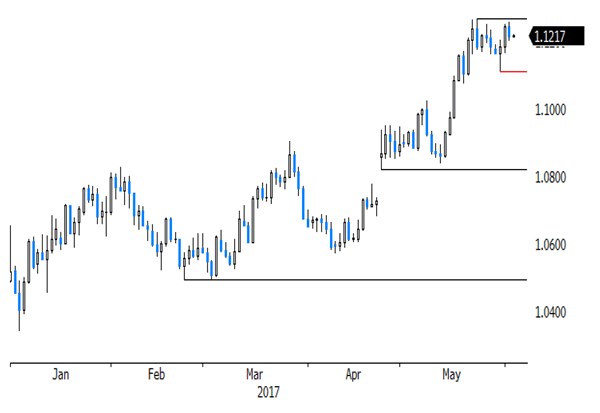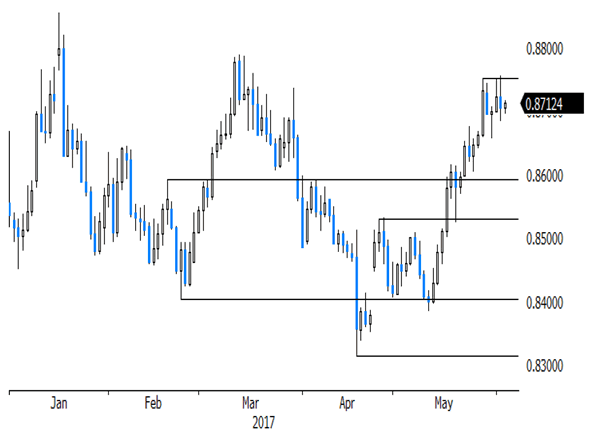Sunrise Market Commentary
- Rates: Decent payrolls sufficient to inflict losses on Treasuries?
Focus turns to US payrolls today. We expect net job growth, unemployment rate and average hourly earnings to be near consensus. Given market positioning, such outcome should be sufficient to trigger a reaction (lower US Treasuries) with the Fed on the brink of another rate hike (June 14) and preparing to taper its balance sheet (Q4 2017?). - Currencies: Will payrolls trigger a USD rebound?
The dollar performed mixed recently, but good data supported a bottoming out process yesterday. Today’s payrolls might decide on the next USD move. Given the recent correction, we see room for a rebound if the payrolls don’t surprise on the downside. Sterling also shows signs of bottoming out even as political uncertainty persists
The Sunrise Headlines
- US equities closed around 0.75% higher with new all-time highs for the S&P 500 and Nasdaq. Overnight, Asian stocks gain ground as well with Japan outperforming (>+1.5%) and China underperforming (-0.5%).
- President Trump said he will withdraw the US from the Paris climate accord in an effort to boost the nation’s industry and independence, making a dramatic shift in policy despite intense lobbying from business leaders and close allies.
- The BoJ hit a new milestone as its balance sheet topped 500 trillion yen ($4.48 trillion), roughly the same size as that of the Federal Reserve, having more than tripled since it started aggressive stimulus in 2013.
- The pace of US car and light truck sales slowed in May for the third month in a row despite steep discounts, but investors bid up shares of General Motors and Ford after executives outlined plans to cut inventories.
- US crude supplies shrank for an eight week, falling by 6.43 million barrels as record refinery runs and exports pushed stockpiles lower, EIA data showed. Still, the drop was smaller than reported by the API and inventories are above the five-year seasonal high. Brent crude hovers just above $50/barrel.
- South Africa’s government has avoided a second damaging credit rating cut from Fitch, but the ratings agency warned that the recent political upheaval is likely to further weaken the economy.
- Today’s eco calendar contains US May payrolls, unemployment rate and average hourly earnings. Fed governors Harker and Kaplan are scheduled to speak.
Currencies: Will Payrolls Trigger A USD Rebound?
Payrolls to decide on USD comeback
Yesterday, the dollar started the session close to the recent lows against the euro and the yen. The EMU data were OK, but not strong enough to push EUR/USD to a new short-term correction top. Later in the session, the dollar even profited from a very strong ADP labour report and from an improving risk sentiment. President Trump announcing that the US is leaving the Paris climate agreement had no negative impact on the dollar or on global risk sentiment. EUR/USD closed the session at 1.1213 (from 1.1244). USD/JPY finished the day at 111.37 (from 110.78). The dollar bottomed out, but the gains remained modest.
Overnight, yesterday’s US equity rally continued in Asia with Japanese indices taking the lead. There are plenty of headlines that the BOJ balance sheet hit the JPY 500 trillion milestone and that it is roughly nearing the same size as the Fed’s. For now, this hardly weakens the yen. USD/JPY touched an intraday top in the 111.68 area but the decline of the yen remains very limited compared to equity performance. The CNH is correcting lower after recent steep gains as funding conditions are easing. EUR/USD (1.1220 area) is little changed from yesterday’s close.
Today, there are no eco data with market moving potential in EMU. US central banks speakers (Harker, Kaplan) already gave their view recently. So the focus will be on the US payrolls report. The market expects a decent report with 182 000 net job growth in May. Yesterday’s ADP report suggests that this is feasible, even as the labour market component in some confidence surveys eased of late. The unemployment rate is expected to be unchanged at 4.4%. Wage growth will be at least as important for markets/the dollar as payrolls growth. The consensus expects average hourly wage growth of 0.2% M/M and 2.6% Y/Y. This looks feasible.
What to expect for the dollar? Until yesterday, the USD performance was far from convincing. An outright miss/disappointment of the payrolls might put the dollar again under pressure with EUR/USD jumping beyond the 1.1268 area and USD/JPY drifting back lower in the 110 area. However, this is not our favoured scenario. After recent USD softness and given the low levels of US yields, an in line/slightly better than expected report might help a further USD bottoming-out process. An ongoing positive equity reaction might also be a slight additional USD positive. So, we look forward to seeing whether the payrolls are strong enough for a floor for the dollar
Technical picture
The USD/JPY rally ran into resistance in early May. A mini sell-off pushed the pair below the previous top (112.20), making the short-term picture negative. The pair regaining to 112.13 level would call off the short-term downside alert in this cross rate. As long as such a sustained rebreak hasn’t occurred, the USD/JPY picture remains fragile and a return action lower in the 108.13/114.37 range remains possible.
Earlier May, EUR/USD failed to break below the 1.0821/1.0778 support (gap). Poor US data and political upheaval propelled EUR/USD north of the 1.1023 range top. The pair reached a short-term correction top at 1.1268. The correction top at 1.1300/1.1366 is next resistance. USD sentiment will have to be extremely negative to clear this hurdle short-term. So, a clean break of this won’t be that easy. A return below 1.1023 would indicate that the upside momentum has eased. Will the payrolls be strong enough to do the job?

EUR/USD declines slightly of recent top. Will payrolls trigger a more pronounced correction
EUR/GBP
Sterling decline halts
UK elections remained the key driver for sterling trading yesterday. The UK manufacturing PMI declined less than expected from 57.00 to 56.7, indicating ongoing good growth in the sector. However the impact on sterling trading was negligible. In technical trade, EUR/GBP touched a minor short-term top in the 0.8755 area, but no sustained break occurred. Most election polls still indicated a lead for PM May’s conservative party, but the lead is declining. After the recent substantial sterling losses, some consolidation seems to kick in. EUR/GBP closed the session at 0.8704 (from 0.8723). Cable finished the day little changed at 1.2882.
The UK construction PMI is expected to ease slightly from 53.1 to 52.6 today. We would be highly surprised to see the indicator having a lasting impact on sterling trading. The focus stays on the parliamentary elections as the campaign enters the final weekend. Political uncertainty remains high, but sterling yesterday entered some calmer waters. Markets apparently have adapted positions to this uncertainty (reducing sterling longs). At the same time, the basic market assumption remains that PM May will maintain a decent majority. Unless polls show a further erosion of the conservative lead, some sterling consolidation might kick in as quite some negative news should already be discounted after the recent sell-off. Next resistance comes in at EUR/GBP 0.8788. EUR/GBP 0.8655 is a first minor support. A sustained return below the EUR/GBP 0.86 alert would suggest that the worst is over for sterling.

EUR/GBP: most of the bad news discounted?













